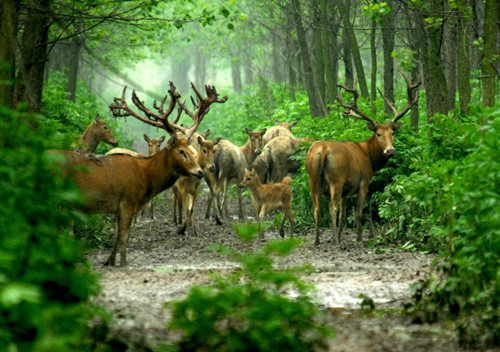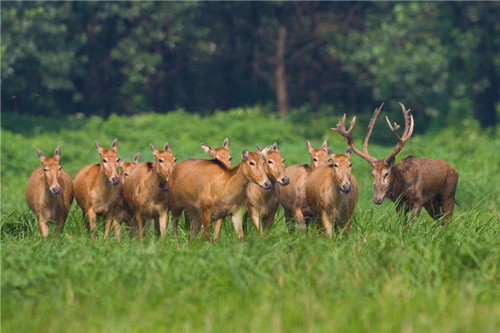Tian'ezhou Milu National Nature Reserve
- Source: Hubei Provincial People's Government
- 10/22/2015 10:15
- 0 739
A herd of Pere David's deer lower their heads to drink water from a mud flat. Always vigilant, they occasionally look around to check for danger. Behind them is a vast land of reeds where they like to hide. Pheasants duck in and out of the reeds and wild geese take to the skies. This is the Tian'ezhou Milu National Nature Reserve in Shishou, Hubei province.


A herd of milu wander in the Tian'ezhou Milu National Nature Reserve in Shishou, Hubei province. Photo provided to China Daily
Surrounding the reserve are miles of farmland dotted with cottages, but in the reserve, animals and nature run wild. There are 1,061 milu - the Chinese name for the deer unique to the country - in the reserve. It's the largest wild herd in China and in the world, all descendents of the 94 deer shipped from Beijing's Milu Park in the 1990s.
A century ago, milu, known as Pere David's deer in the West, were said to no longer live wild in China. There were only 18 of the animals living in China in 1898. The shortage was the result of European zoos' desire to collect exotic animals. In 1986, 22 milu were reintroduced to Beijing's Milu Park and another 39 were later shipped to Dafeng in Jiangsu province from Britain.


A herd of milu wander in the Tian'ezhou Milu National Nature Reserve in Shishou, Hubei province. Photo provided to China Daily
Tian'ezhou milu reserve is not open to the public. Only staff or experts conducting research are allowed to visit the wetlands.
The 1,567-hectare reserve was established in 1993, aiming to return the deer into the wild. Adjacent to the reserve is China's finless porpoise reserve that shares the same waters with the deer reserve. The marshlands and reeds make it a perfect habitat for milu.


A herd of milu wander in the Tian'ezhou Milu National Nature Reserve in Shishou, Hubei province. Photo provided to China Daily